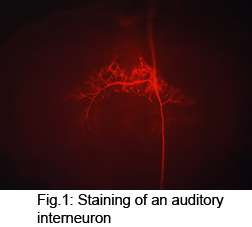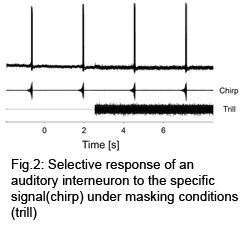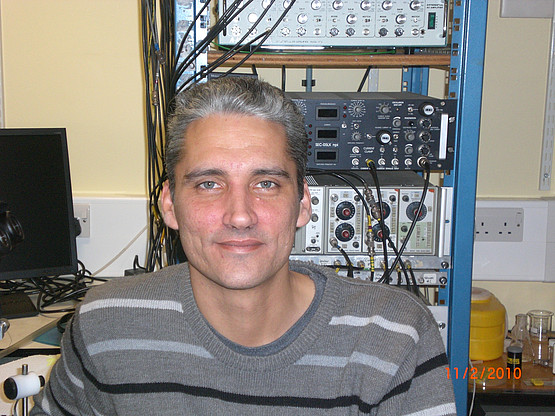Research
My research topics focus on the neuroethology of acoustic communicating insects where I combine behavior with the underlying neurophysiology. Insects as model systems provide the advantage that principal neural mechanisms that have an impact on behavior such as signal identification or directional steering can be analyzed at the level of single, identified neurons. I have particularly focused on signal processing, signal identification under noise and temporal pattern recognition in neural networks of insect brains. I also analyzed the sensory-to-motor interface in insect brains that generates motor commands for steering behavior. I combined behavioral studies on a high resolution trackball with long lasting, extracellular recordings of central, auditory interneurons. I developed delicate methods for simultaneous recordings from bilateral ascending, auditory interneurons in small insects and established techniques to study the activity of such interneurons in the field analyzing environmental influences on sound processing, signal detection and directional hearing. I am highly experienced in performing intracellular recordings from small, auditory brain neurons and staining of these neurons by using fluorescent dyes.
During my Newton international fellowship at the University of Cambridge I analyzed neural networks for temporal pattern recognition in the brain of crickets and revealed the neural mechanism for temporal pattern recognition based on fast interactions between excitation and inhibition and a coincidence detection principle by neuronal delay lines. Such recordings require experience, endurance and excellent dissection skills to access the central nervous system of the insects.
In my current position as a University assistant at the University of Graz I analyze multimodal signal processing and signal detection under biotic noise in sympatric living katydid species.
Neural networks are crucial for the computation of sensory signals and the generation of appropriate behavior. Bushcrickets of the genus mecopoda reliably detect their conspecific signal in behavioral trials even when background noise is louder. By using intracellular recordings I analyze auditory processing and signal identification within the central nervous system of females.
1. One major aim is to analyze how signal detection and pattern recognition is established in auditory neurons and within neural circuits of the central nervous system of bushcrickets leading to a selectivity for species-specific features of the calling song.
2. Response properties of identified auditory neurons are compared between two closely related species of Mecopoda that use different calling songs. Differences in neural responses to specific features and under masking conditions by the heterospecific signal may highlight how response properties of neurons are shaped by sexual selection.
3. In a classical neuroethological approach selective responses of neurons are compared with behavior. Neurons that match the behavioral selectivity are likely to be the last stage of auditory processing before transforming auditory information into motor commands. I also analyze the responses of descending pre-motoneurons that receive auditory inputs and are likely to control behavior.
4. Behavior is a result of complex processing of sensory signals of various modalities. A major aim is the analysis of the multimodal sensory integration in the brain of two closely related bushcricket species. I distinguish between signals for close range communication (olfactory, thermal) that are integrated in centers for final mating decision, and signals for long range communication (auditory, vibration) that elicit steering behavior towards the signaling mate. Responses of descending pre-motoneurons reveal how multimodal signals are integrated and shape the motor commands for phonotactic behavior.




